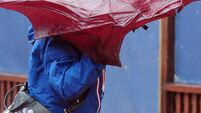The islands of Ireland: Inishark - The island of hardship

On October 20, 1960, the remaining inhabitants of one of Ireland’s most westerly islands stood on the pier and said goodbye to an entire way of life, writes
It was the end of the road on Inishark for the minuscule population of 24 on the County Galway island. The death of a young man from appendicitis was the catalyst and the islanders pleaded with the Government to take them off the island.
The Cloonans, Gavins, Laceys and Murray families packed their belongings and left the island forever. They settled in the towns and villages to the east with their former home now just a memory.
Inishark or Inis Airc, (Island of Hardship), is in Connemara and lies just to the south of Inishbofin and about 14km from the village of Cleggan in west Galway. Without electricity and without a doctor, life was getting harder and harder. Its oarsmen were regarded as the best in Ireland but the island had numerous fishing tragedies over the years. Unlike neighbouring Inishboffin which has a superb harbour, the pier in Inishark was sited in a dangerous place with vicious currents.
When the Irish Examiner visited, landing was only possible by waiting for the boat to rise up on the swell and then jumping onto the remains of the pier.

It is a very lonely thing to walk among the houses where once neighbours bantered and children played. Most of the roofs are since caved in but these houses were strongly built and have resisted the battering Atlantic. Standing among them are the old schoolhouse and the church of St Leo’s.
The 1950s and 1960s saw many islands from Cork to Donegal evacuated: Great Blasket Island in 1953; East Skeam in 1958; Iniskeas in the 1960s. An entire way of life coming to an end.
The experience of Inishark islanders was captured in a TG4 documentary in 2007 which interviewed some of the surviving islanders and included footage of the evacuation. Inis Airc, Bás Oileáin (Inishark, Death of an Island is more than a window into the past - it is a valediction to a way of life, almost a way of being.
The Inishark population peaked at 208 in 1881 while its more sizeable neighbour Inishbofin had 1,200 people. The people of Inishark used to row across for provisions and to go to the post office and to mass.
The people of Inishark and Inishboffin were very close, you could go into someone else’s house and have a cup of tea’” said a contributor to the film, Teresa Lacey.
Kieran Concannon’s film shows the islanders carrying their personal belongings from their houses and walking a few hundred metres to the pier: chairs, wardrobes even windows frames were removed. “It’s a sad sight to see a place deserted. It doesn’t matter what little corner of a country is deserted the country is poorer as a result. it’s a sad sight to behold an island that was so lively and which had such cheerful inhabitants and now there are just birds going in and out of the houses,” said one interviewee, Eamon Mac an Ri.
Ultimately, the island was abandoned to the elements. Not everyone was nostalgic. “I was delighted to get off the island. It was no place for any human being to live,” said George Murray at an islanders’ reunion in 2010.
For the last few years Inishark has been the focus for an intensive archaeological dig by the University of Notre Dame students. Their work included an examination of the kelp industry and of emigration and in addition to excavating the more recently inhabited houses, they also looked at much more historic artefacts.
This is the quintessential deserted village. In Oliver Goldsmith’s 1770 poem ‘The Deserted Village’ Inishark might as well have been his subject:
“Low lies that house where nut-brown draughts inspired, Where grey-beard mirth and smiling toil retired, Where village statesmen talked with looks profound, And news much older than their ale went round.”
All now quieted. Inishark is forlorn but not forgotten.
- How to get there: Boats can be chartered from Aidan Day on Inishbofin: 086 832 4123










